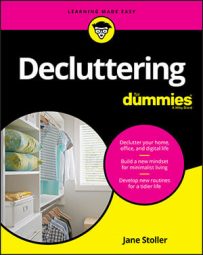Which receipts to keep
I don’t keep the receipts for everyday personal purchases. If you’re budget tracking, then maybe you want to keep them to help stay on track. Or you may want to keep a receipt if you feel like you want to return something (although most stores now also have records of purchases). Give yourself a deadline if you think you might return something. I like giving myself a week to decide whether or not I want to keep a purchase. Sometimes we forget to return things, which adds to our clutter. Even if the store has a policy of 90-day returns, make it a point to give yourself that one-week timeline.I generally keep the receipt for anything valuable or expensive, such as large electronics or jewelry, for insurance purposes.
It’s a good idea to keep some receipts for your personal tax return, whether you have a business or not. Different tax laws will dictate what you can add to your personal tax return; for example, healthcare, travel, and anything you had to buy for your job could be deducted. Check with your accountant, as they will be able to tell you what you should keep for your personal tax return. If you have a business, you are likely aware that you need to keep all receipts for your business from restaurant bills to supplies to advertising. You need to keep them to be able to write off purchases, which is important for businesses.
From today onwards, start a system. I have a system that categorizes work, personal, and short-term purchases (for anything I might return, which I only keep for one week in my wallet). Under work, I keep all my receipts for business expenses, and under personal, I keep anything of value for insurance purposes.
Once you have your system, stick to it. If you want to tackle the receipts before you start this system, carve out 15 minutes a day with the help of a time cube (purchased from my website) until you’re caught up. If I’m being honest, this will be a painful task and will motivate you to never let receipts pile up again.
Don’t be nervous to get rid of receipts. Usually, you don’t need them and many retailers store them electronically. The most important thing is to set up a system and stick to it going forward. Also, if you find a receipt that doesn’t fit into any of your categories, you likely don’t need to keep it.
How to store receipts
You can go old-school and create bins and envelopes and continue to have to deal with your receipt clutter for years, or you can simply go digital.You guessed it: I recommend digital receipt storage. Actually, I say it is a must because these days, if you decide on the old-school method and you actually need to use/find one of the receipts, I guarantee one of two things: You either won’t find it, or when you do, it will be so faded that you won’t be able to read it.
Get an app and go digital. Avoid scanning receipts, as this can take hours. Instead, use your phone to take a picture from the app for it to automatically upload to software and be stored in the cloud. I use the NEAT app, which then further connects to my accounting software. If you use the Google receipt app, you get tons of choices. Once you find an app, the key is to create a system and declutter receipts regularly.
The following figure depicts how I scan my receipt and then what it transfers to onto the app. The information is automatically populated. You can even have humans verify the information for a small fee. The nearby sidebar lists my favorite receipt apps.
 Image courtesy of Jane Stoller
Image courtesy of Jane StollerScanning receipts into an app is super easy.
Get in the habit of taking the photo with the app and then moving the photos on a weekly basis to the folders you created for your system. Be committed to this system and schedule weekly time in your calendar for this step. Then, when you do your annual taxes, you can quickly delete by month, year, and so on, and they will never build up.
Most of the apps keep the receipts in the cloud, so there is no need to keep the physical copy. If you feel safer keeping a copy on your hard drive, that is also an option, but I trust the cloud.Receipt tracking apps
There are tons of options for tracking receipts. Here I share my top three from my usage and trials with them:- Neat: This was actually the company that used to sell a portable scanner. I saw them all the time in airports. I use NEAT because it is simple to scan with my phone, and it connects to my accounting software, which is QuickBooks.
- Expensify: This is one of the most popular receipt tracking apps, and I found it very easy to use.
- Zoho Expense: This app offers many business software solutions, including a CRM that can also be linked to receipt tracking.

